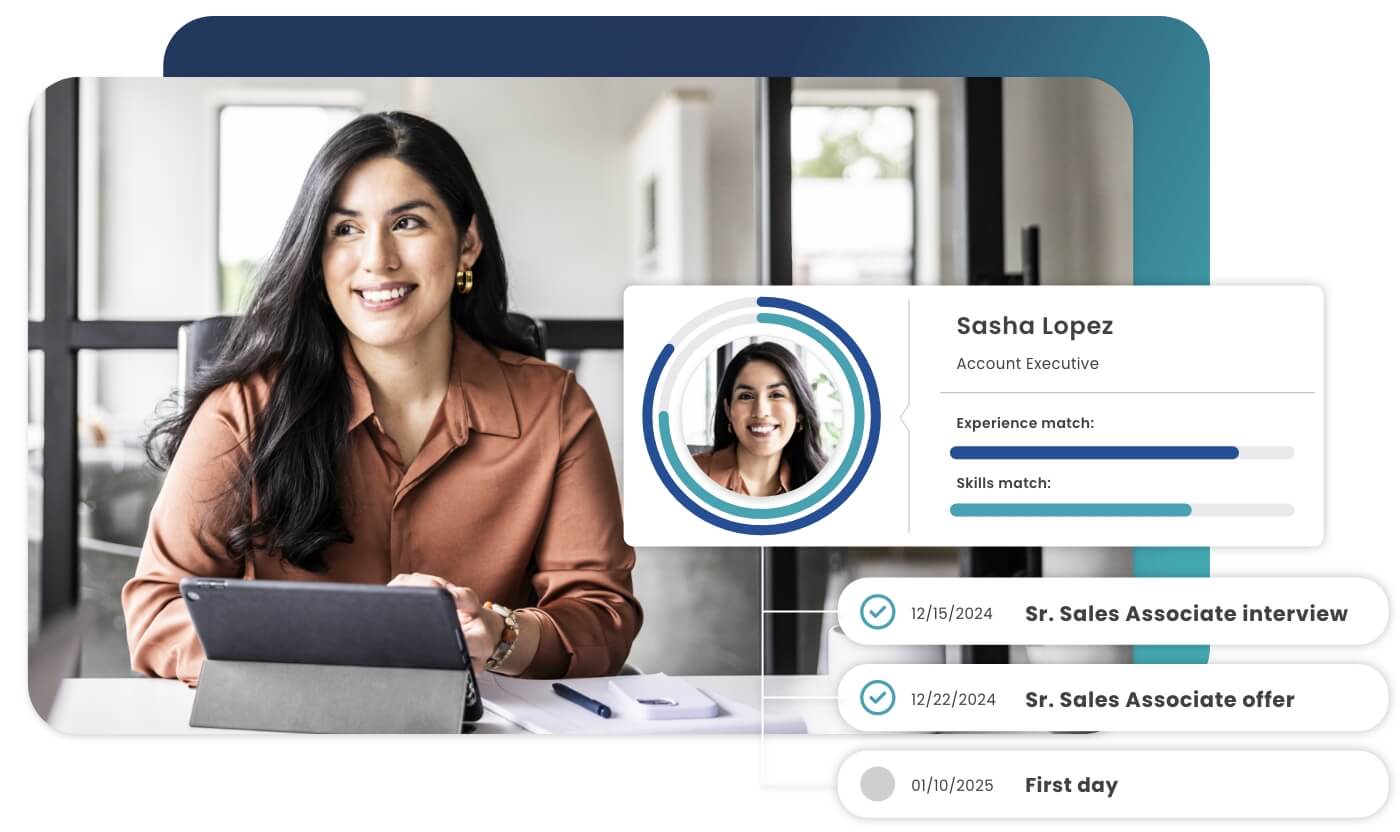

There is a name for the process of winnowing down candidates step by step until only new hires remain: it’s called a recruiting funnel. It starts with many applicants, some of whom are screened out. Then there are candidates; they too shrink in number as phone screens and interviews take place. This brings you to a short list of finalists; then new hires.
In the article below, we will further investigate the purpose and function of a recruitment funnel, providing best practices and real-world examples along the way.
A recruitment funnel represents the steps talent teams take to move candidates through the hiring process. Like a sales funnel, the recruitment funnel narrows as it reaches its final destination — in this case, new hires — removing candidates at each stage.
When organizations implement a structured hiring process, they position themselves to create a hiring funnel that is optimized at every stage. A hiring funnel incorporates several distinct steps, each of which comes with its own purpose and set of best practices. Organizations that approach these stages with purpose are better able to achieve the goals inherent to each step.
The benefits of using a recruitment funnel are widespread. A recruitment funnel leads to better processes and practices, improvements that boost the candidate experience, elevate the quality of hires, and even result in time and cost savings.
Below, we define the fundamental elements of a robust recruiting funnel and name the metrics that propel progress.
The recruiting funnel begins with awareness. Employers must make themselves known to a large number of potential candidates to attract future applicants. Efforts include creating job posts, developing a social media presence and encouraging employee referrals.
These strategies aim at a singular goal: developing a strong employer brand and communicating a thoughtful employee value proposition.
Metrics: Measure awareness by tracking views, clicks and shares on job posts and social media content.
The next step in the recruiting funnel is attracting candidates and encouraging them to apply. While the awareness stage focuses on reaching a general audience, the attraction stage targets a more specific group. Employers may create blog posts or videos to appeal to ideal candidates.
Like in the previous stage, an online presence remains key to attracting candidates. Organizations that build an online community through efforts like blogs and email newsletters will create a strong pool of interested candidates who are primed to apply for open roles.
Metrics: By cross-tracking metrics like email and blog subscribers with application stats, employers can pinpoint the efforts that are most successful.
Next, it’s time for employers to nurture the relationships developing among candidates. Employers can nurture candidate relationships through varied forms of contact.
Some candidates will respond to short, frequent emails updating them on company news, familiarizing them with company benefits, and briefing them on the application process. Other candidates will enjoy more personal opportunities, like webinars and in-person events.
Metrics: By tracking email open and click rates and event registrations, employers can measure the success of their interest efforts.
Once candidates are familiar with an organization, it’s time to push them to apply. It’s essential that employers make it easy for job seekers to apply to their organization.
One way to accomplish this? Optimize application forms for conversion. Applications should feel as effortless as making an online purchase. Companies should collect only the essential information at this stage — they can follow up with promising candidates later.
Employers can also enable their application process for mobile devices. Candidates desire quick applications that can be accomplished on their smartphones.
Metrics: To assess the state of your application process, track both application completion rate and time to apply. These metrics will reveal how many candidates abandon their applications — and how long it takes those who commit to the entire process.
Just like the application stage, it’s important to keep evaluations quick. Employers can use AI tools at the beginning of this process to promote the resumes of candidates whose skills most closely align with an open role.
Employers can make the most of the evaluation stage by conducting pre-employment assessments. Often virtual, these tests reveal which candidates are most suited to a given role. These assessments also help eliminate candidates who would likely flounder on the job.
Metrics: Employers should keep track of the number of applicants screened and the assessment pass rate.
The interview stage is the last chance employers and applicants have to impress the other. That’s why employers need to provide candidates with an exceptional interview experience.
Employers can create consistent interviews by using structured questions to assess candidates’ skills and cultural fit. Employers should train interviewers to put candidates at ease and represent the employer well.
Metrics: Employers can track the number of interviews conducted. As employers refine their interview process, they should see how post-interview candidate satisfaction changes.
Finally, it’s time for employers to make a hire. Employers must remember that they’re continuing to compete for candidates, even in this final stage. Employers should extend compelling, competitive job offers that convince candidates to accept their new role immediately.
Employers should continue their efforts to ensure a smooth onboarding experience for new hires. This transition period is an appropriate moment for employers to solicit feedback on the hiring process from new hires.
Metrics: Employers should track offer acceptance rate, time to fill, and new hire retention.
Employers that want to make the most of their recruitment funnel must enlist the help of data and technology. The most foundational step is to set up funnel tracking with an application tracking system (ATS) or candidate relationship management tool.
One of the chief benefits of this approach is the in-depth data these tools can provide. iCIMS ATS, for example, offers custom reporting so talent teams can act on the metrics that matter most to them. This information offers teams the ability to optimize their recruitment process — and measure their progress as they grow.
Employers can take a number of steps to continually refine their recruitment funnel.
Organizations spending time, money and effort on their recruitment funnels will want to prove the value of their work.
There’s no one way to measure the ROI of a recruitment funnel. In fact, it’s best that employers take a multi-pronged approach. Employers can begin by tracking cost-per-hire and time-to-fill and watching how these rates change as they refine their recruitment funnel.
Next, employers can track the quality of hire and retention rates. These metrics reveal whether an employer’s recruitment funnel is successful in churning out quality candidates. If employers are dissatisfied with their hires, they may need to make changes to even the earliest stages of their funnel.
Finally, organizations can tie hiring results to business KPIs like revenue and productivity. Over time, elevation in the candidate quality should result in better business outcomes.
Recruiting teams that have taken care to optimize their recruiting funnels and track metrics like these need to make leaders aware of their efforts. They should present funnel metrics to leadership in terms that demonstrate the impact of their efforts, in language that leaders less familiar with the recruiting function can understand and appreciate.
Want to see a recruiting funnel in action? Look to companies like Benefit Cosmetics.
The California-based beauty company had no shortage of candidates, but it needed a quick way to move job seekers down the recruitment funnel.
Benefit added video interviewing as an early step in the hiring process. The switch gave candidates a chance to practice their interview skills and allowed recruiters to get a better idea of candidates’ skills before moving to the next round of interviews.
“The face-to-face [interview] is still important in making genuine connections with candidates, but it is now further into the process, creating efficiency for both the candidate and recruiter,” said Danah Leneghan, resourcing manager at Benefit Cosmetics.
Talent teams looking to improve their recruiting funnels are bound to encounter challenges. Here are a few of the most common funnel frustrations — and some ideas about how to solve them.
Recruiting funnels don’t just exist to boost application rates or improve time to hire. Their implementation can also help improve the candidate experience. By following these key best practices, talent teams can leverage recruiting funnels to provide a stellar experience for job seekers.
If you’re ready to optimize your recruiting funnel, learn more about iCIMS ATS. Our platform equips recruiters with the tools they need to succeed at every stage of the hiring process. Book a demo today.